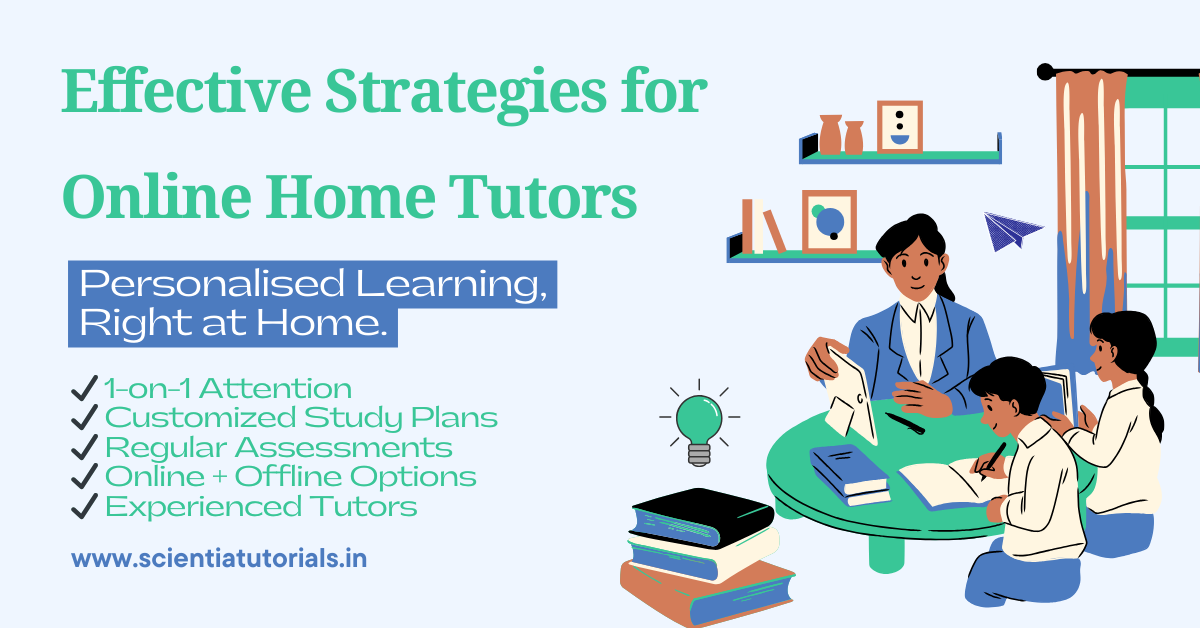
Keeping Students Engaged: Effective Strategies for Online Home Tutors
In recent years, online tutoring has gained immense popularity, offering flexible learning options for students and convenience for tutors. However, one of the challenges of virtual learning environments is maintaining student focus. Distractions abound in a home setting, and without the physical presence of a tutor, students may struggle to engage fully with the material. This article provides teaching tips for home tutors to help keep students focused during online sessions, ensuring an effective and productive learning experience.
Understanding the Online Learning Landscape
Before diving into specific strategies, it’s crucial to understand the unique challenges that online learning presents:
- Distractions: Students may have access to phones, games, and other distractions that can pull their attention away from the lesson.
- Limited Interaction: Online settings can sometimes feel impersonal, leading to a lack of engagement compared to face-to-face interactions.
- Variability in Learning Environments: Each student’s home learning environment varies widely, impacting their ability to focus.
Recognizing these challenges is the first step in creating strategies to overcome them.
Setting the Stage for Success
Create an Optimal Learning Environment
The learning environment plays a significant role in a student’s ability to focus. Here are some tips for tutors to help students create an optimal space for learning:
- Dedicated Study Area: Encourage students to set up a specific area for studying. This area should be quiet, well-lit, and free from distractions. A designated study space helps signal to the student that it’s time to focus.
- Minimize Distractions: Suggest that students turn off notifications on their devices, close unnecessary tabs, and use tools like website blockers to limit access to distracting sites during tutoring sessions.
- Organize Materials: Having all necessary materials at hand can help minimize interruptions during lessons. Students should prepare their textbooks, notebooks, and any required tools before the session begins.
Establish a Routine
Routines can significantly enhance focus and productivity. Here’s how to create an effective tutoring routine:
- Regular Schedule: Encourage students to stick to a consistent schedule for their tutoring sessions. Regularity helps them mentally prepare for each lesson.
- Session Length: Tailor the duration of the sessions to the student’s attention span. For younger students, shorter sessions of 30-45 minutes may be ideal, while older students may benefit from longer sessions.
- Breaks: Incorporate short breaks into the routine, especially for longer sessions. A 5-10 minute break every 30-45 minutes allows students to recharge and return to the material with renewed focus.
Engaging Students During Sessions
Utilize Interactive Tools
The online learning environment offers a plethora of tools to engage students actively. Here are some effective strategies:
- Interactive Platforms: Use platforms that facilitate interactive learning. Tools like Google Jamboard, Padlet, and Kahoot! allow for collaborative activities, quizzes, and brainstorming sessions that keep students involved.
- Visual Aids: Incorporate multimedia elements such as videos, slideshows, and infographics to make lessons more engaging. Visual aids can help break the monotony of text-heavy lessons.
- Real-Time Collaboration: Encourage students to participate actively by collaborating on assignments in real-time. Shared documents can promote teamwork and keep students focused on a common goal.
Foster Student Participation
Active participation is crucial for maintaining focus. Here are strategies to encourage engagement:
- Ask Questions: Encourage students to ask questions and express their thoughts during sessions. Open-ended questions can stimulate discussion and critical thinking.
- Incorporate Games: Use educational games to reinforce concepts and make learning enjoyable. Gamification can turn lessons into fun challenges that motivate students to stay focused.
- Encourage Peer Learning: If appropriate, involve other students in group sessions. Collaborative learning fosters a sense of community and encourages engagement through peer interaction.
Tailoring the Learning Experience
Adapt to Individual Learning Styles
Recognizing that each student has a unique learning style is essential for keeping them focused. Here are some tips for adapting your teaching approach:
- Visual Learners: Use diagrams, videos, and charts to explain concepts. Visual learners benefit from seeing information represented graphically.
- Auditory Learners: Incorporate discussions, podcasts, and verbal explanations. Auditory learners may thrive in environments where they can listen and engage in dialogue.
- Kinesthetic Learners: For students who learn best through hands-on experiences, incorporate interactive activities, such as experiments or practical exercises, that allow them to engage physically with the material.
Set Clear Objectives
Establishing clear objectives for each session helps students stay focused. Here’s how to do it:
- Lesson Goals: At the beginning of each session, outline specific goals. For instance, instead of just covering a topic, state that the goal is to understand key concepts and apply them in practice problems.
- Progress Tracking: Use progress tracking tools to visually demonstrate how much has been accomplished over time. Students may find motivation in seeing their advancement.
- Celebrate Achievements: Recognize milestones, no matter how small. Celebrating achievements boosts motivation and encourages continued focus.
Building a Positive Tutor-Student Relationship
Communicate Effectively
A strong tutor-student relationship fosters trust and engagement. Here are some communication tips:
- Establish Rapport: Start each session with a friendly check-in. Asking about their day or interests can help create a comfortable atmosphere.
- Be Approachable: Encourage open communication. Let students know they can express their concerns or challenges without judgment.
- Provide Constructive Feedback: Offering feedback in a supportive manner helps students understand their progress and areas for improvement without feeling discouraged.
Encourage Self-Reflection
Helping students reflect on their learning can enhance focus and motivation. Here’s how to incorporate self-reflection:
- Reflection Journals: Encourage students to keep journals where they reflect on what they learned, their challenges, and their successes after each session.
- Goal Setting: Assist students in setting personal academic goals. This process encourages ownership of their learning journey.
- Regular Check-Ins: Schedule periodic discussions to review goals and assess progress. This practice promotes accountability and keeps students focused on their objectives.
Leveraging Technology for Engagement
Use Multimedia Resources
Technology can enhance the learning experience significantly. Here are some ways to use multimedia effectively:
- Educational Videos: Integrate short, relevant videos to explain concepts visually. Platforms like YouTube and educational websites can provide valuable resources.
- Virtual Reality (VR): If possible, use VR tools for immersive experiences. For example, virtual field trips can make subjects like science or history more engaging.
- Podcasts and Audiobooks: Recommend educational podcasts or audiobooks related to the subject matter. These resources provide alternative ways for students to engage with content.
Incorporate Homework Tools
Homework tools can help reinforce learning outside of tutoring sessions. Consider these options:
- Study Apps: Introduce students to study apps like Quizlet, which allows them to create flashcards and practice concepts independently.
- Collaboration Tools: Suggest collaborative platforms like Google Drive, where students can work on group assignments seamlessly.
- Online Forums: Encourage participation in educational forums or discussion groups related to their subjects. Engaging with peers in an online community can spark interest and motivation.
Conclusion
Keeping students focused during online home tutoring sessions requires a multifaceted approach that addresses the unique challenges of virtual learning. By creating an optimal learning environment, utilizing interactive tools, tailoring the experience to individual learning styles, and fostering a positive tutor-student relationship, home tutors can significantly enhance student engagement and academic success.
As online education continues to evolve, implementing these strategies will not only keep students focused but also foster a love for learning that extends beyond the virtual classroom. By remaining flexible and adaptive, home tutors can navigate the online learning landscape and make a lasting impact on their students’ educational journeys.


